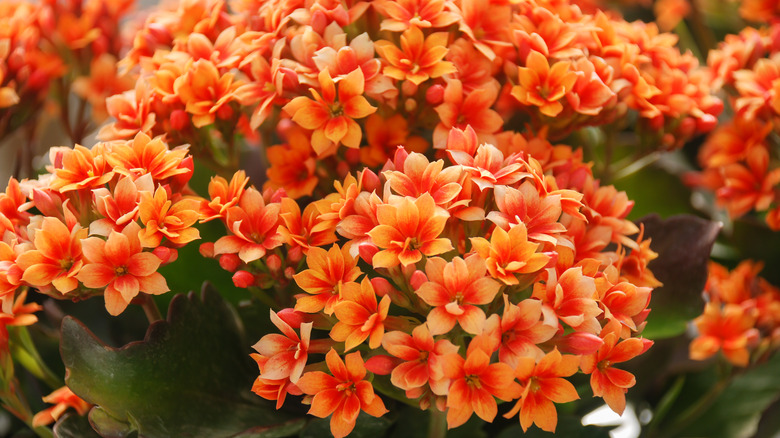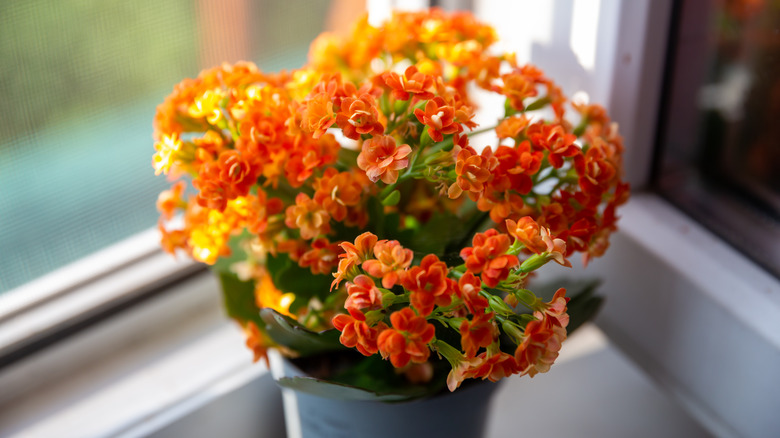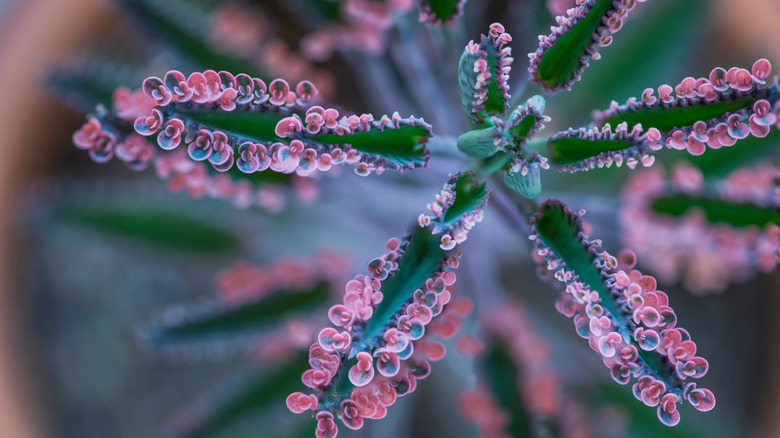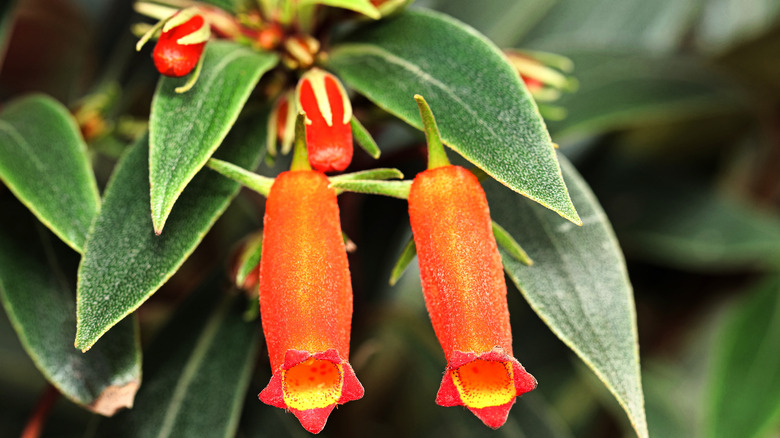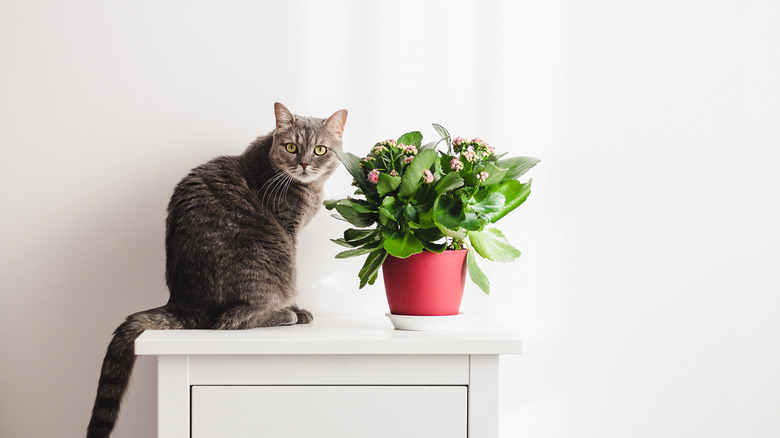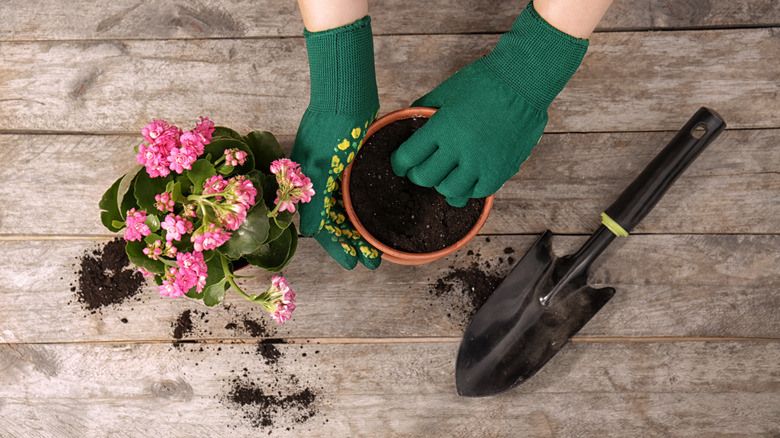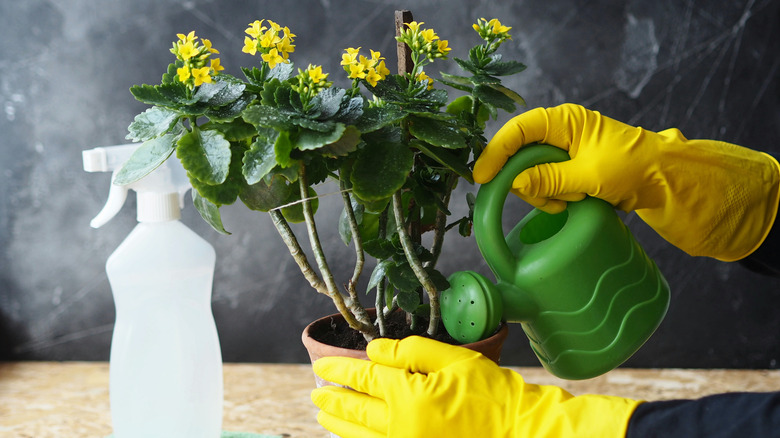How To Grow And Take Care Of Kalanchoe
There are over 100 species in the genus Kalanchoe, but only a few species of the herbaceous, flowering succulents are well known today. The most popular species, Kalanchoe blossfeldiana, simply called Kalanchoe or by the nickname Flaming Katy, according to Bob Vila, is one of the few succulents desired specifically for its blooms of red, orange, white, yellow, or pink. The leaves are glossy dark green with scalloped edges. Mature plants can reach 8 to 12 inches tall.
Outside of zones 10 to 12, kalanchoes don't make good plants for outdoor gardens due to their cold sensitivity and need for longer nighttime periods, which is essential to the formation of their blooms. It only takes a few hours of temperatures below 40 degrees to kill your kalanchoes, as per SFGate.
Many people tend to throw kalanchoes away when they are finished with their weeks-long blooming cycle, but they can live for many years and will rebloom again and again under the right conditions. Kalanchoes are sometimes planted in containers with other related succulents, such as aloe, but they tend to be more successful in their own containers where there is less competition for the soil's nutrients. This really is the perfect houseplant for those of us who forget to water on a regular basis because they love dry soil.
How to grow kalanchoe
Depending on the variety, Kalanchoe drops seeds or tiny plantlets, but it is often faster and more convenient to propagate stem or leaf cuttings of the plant instead, explains Bob Vila. To grow from seeds, collect the seeds that fall after the plant blooms and place them in a container of moist soil. You should surface sow the seeds, meaning they should not be covered by soil because they require sunlight to begin germination. To create a mini-greenhouse for your seeds, place the container in a plastic bag or cover it in plastic wrap. This will trap moisture and help generate humidity. According to The Spruce, the seeds should begin to germinate within ten days but won't be large enough to transplant for at least two months.
To propagate by leaf-cutting, cut or pluck a plump, firm leaf from the stem. If propagating by stem cutting, cut a section of stem at least 3 inches long. Leave the cuttings to dry in an environment with good air circulation for at least three days until the ends have been calloused over. Plant the cuttings in moistened succulent potting soil and store them in bright, indirect sunlight. You can also use a potting medium combination of 50% perlite and 50% peat moss. The propagated cuttings will be ready to be transferred to their own containers within four to six weeks.
How to care for kalanchoe
Kalanchoe has specific needs when it comes to water, soil, and sunlight, but if these conditions are consistently met, your plants can easily thrive for years to come. Bob Vila explains that kalanchoe prefer a well-draining potting mix. A pre-packaged succulent potting mix will be fine for your plants, but you can also mix your own combination of 75% perlite and 25% peat moss. This combination is great for drainage while retaining just enough moisture for the potted succulent. The frequency of watering will depend largely on the plant's immediate environment, so it's easiest to check your soil to determine whether to water. Stick your finger in the pot. Don't water until the top inch of soil has lost all moisture.
Kalanchoes need plenty of bright, indirect sunlight, but the amount of sunlight differs depending on the time of year. Too much direct sunlight can turn their leaves purple or scorch them. Equally as important as the type of sunlight is the amount of sunlight and nighttime hours. Kalanchoes need at least six weeks of shorter day cycles and longer night cycles for flowers and buds to fully develop. When blooms have faded or begun to wilt, pinch the stems off at the base of the plant. This process of deadheading will trigger more blooms to grow instead of wasting the plant's nutrients and energy on the dying blooms.
Common pests, like mealybugs, spider mites, and scale insects, can be avoided with proper watering.
Kalanchoe varieties
There are over 100 species in the Kalanchoe genus of stonecrop succulents (Crassulaceae), most of which are native to Madagascar. There are several varieties that are popular choices as easy indoor plants. Foliage can have waxy or hairy texture.
- The Flower Dust Plant (Kalanchoe pumila), with light pink and violet blooms and foliage covered in white hairs, is a fantastic choice if you are looking for a unique plant for your hanging baskets.
- Lanin Kalanchoe has orange blooms and waxy dark green foliage.
- A hardier variety that can survive outdoors in zones 9 to 11 is Kalanchoe manginii, also called beach bells. Beach bells kalanchoe has rounded leaves, and mounds of bell-shaped flowers can vary between pink or red. It is a fast-growing yet short stature variety that spreads about 3 feet in width at maturity. Because flowers of the beach bells kalanchoe hang downward from wiry, arching stems, this variety makes wonderful hanging baskets.
- Kalanchoe 'Wendy' has unique violet bell-like blooms tipped in pale yellow with thick evergreen leaves that are classic among succulents.
- Kalanchoe rhombopilosa, Pies from Heaven, is famous for thick fan-shaped foliage dusted with a silver sheen and copper mottling. The flowers can range from yellow to pink with purple streaks.
Is kalanchoe toxic?
Humans should not ingest kalanchoe due to its toxic compounds. Use gloves when interacting with a plant that has broken stems or leaves, and wash your hands frequently because the sap from the plant can cause toxic effects if rubbed in your eyes or accidentally ingested.
According to the ASPCA, all species of kalanchoe are also toxic to all pets and livestock. The level of toxicity ranges from mild to moderate, but all parts of the plant are toxic, including the water from the vase or container. The flowers are the most toxic because they contain the highest concentration of Bufodienolides, a cardiac glycoside that, when ingested, can cause vomiting, diarrhea, and irregular heart rhythm. It is important to be careful when allowing dogs, cats, and small children near plant varieties like Mother of Thousands, which drop hundreds of tiny plantlets instead of seeds. Each of these plantlets is also toxic and can be easily swallowed by toddlers, cats, dogs, or birds. The best way to protect pets and children from accidental consumption is to clean the surrounding area frequently and discard the plantlets that fall from the mother plant.
How to repot kalanchoe
Kalanchoe don't need to be repotted very often, but there are certain conditions which may require you to repot. In general, kalanchoe may only need to be repotted every other growing season. However, kalanchoe don't like to be root bound like some other plants and may begin to wilt and die if the container is too cramped.
Terracotta pots are perfect because they draw moisture away from the roots, promoting the aerated, well-draining conditions necessary for kalanchoe health. While kalanchoes are sensitive to overwatering, it's important to make sure your soil is not drying out too quickly, as per Bob Vila. If your soil is extremely dry and won't retain any moisture, repot the kalanchoe in a new pot with fresh soil.
To repot, you'll need a pot that is one size larger than your kalanchoe's current pot. Increase aeration and drainage by adding a layer to the bottom of the terracotta pot with gravel or broken shards of old terracotta pots. Remove your kalanchoe from the old container and gently shake away old soil from the roots. Place the plant in the new pot, adding a layer of potting medium until you can situate the kalanchoe's crown is about 1/2 inch below the rim of the pot. Fill in around the roots with new soil until the soil level is up to the crown and gently tamp down with your fingertips.
How to use fertilizer with kalanchoe
You may need to fertilize your kalanchoe more frequently if it has been a while since you last repotted it. Nutrients that were preloaded in the packaged potting medium will have been depleted over time. Choose a slow-release fertilizer with a balanced 20-20-20 amounts of nitrogen, phosphorous, and potassium if your kalanchoe hasn't been repotted for at least three months. The Spruce advises using this fertilizer once a month.
Bob Vila advises adding extra fertilizers every couple of weeks through the growing season, like a 20-8-20, for extra nitrogen and potassium to promote plant health and growth. If you repot your kalanchoe regularly, there is no need to add fertilizer during the winter months, but some like to add a 0-10-10 in late winter when the first buds are beginning to form. If your kalanchoe isn't producing as many blooms during its growing season in spring, summer, and fall, add a fertilizer that is higher in phosphorous.
